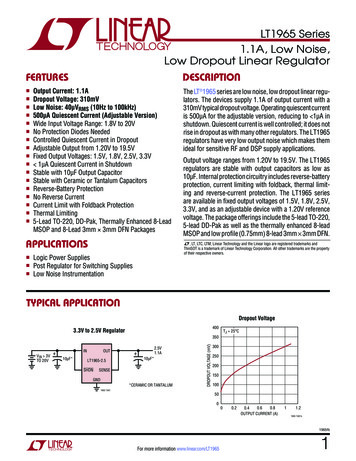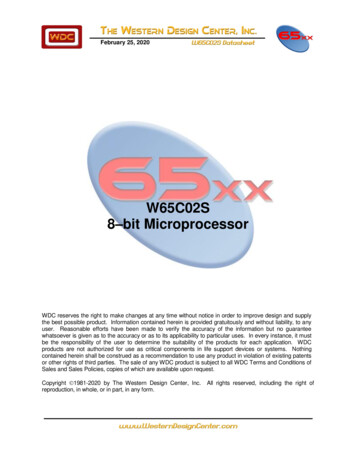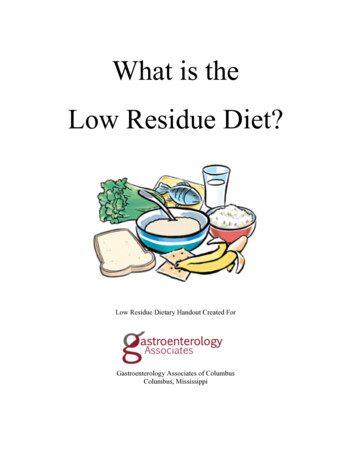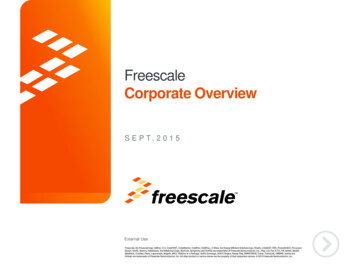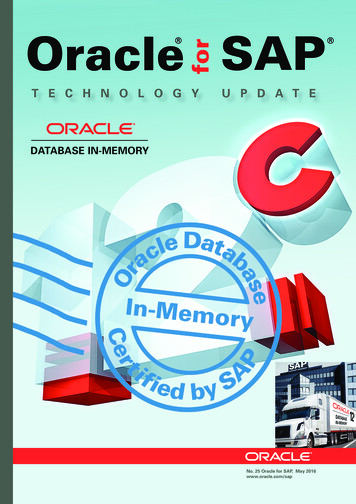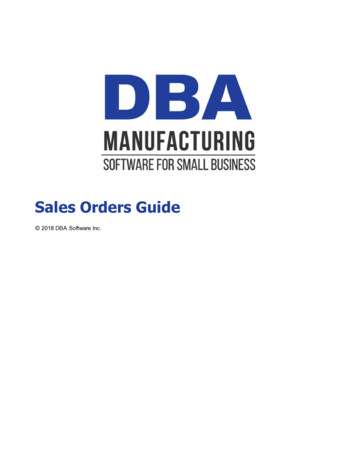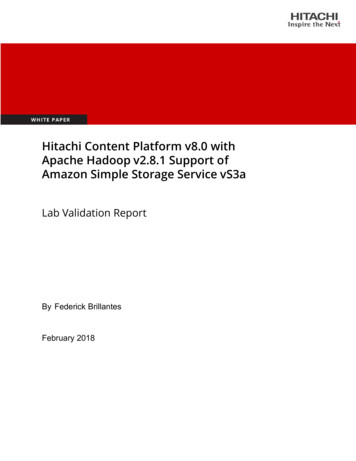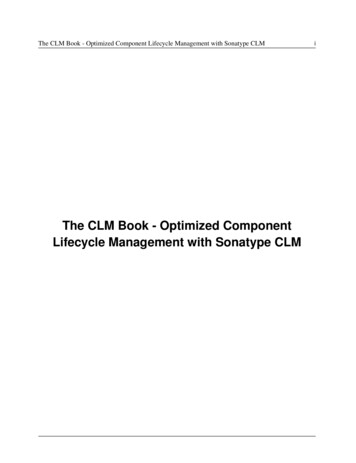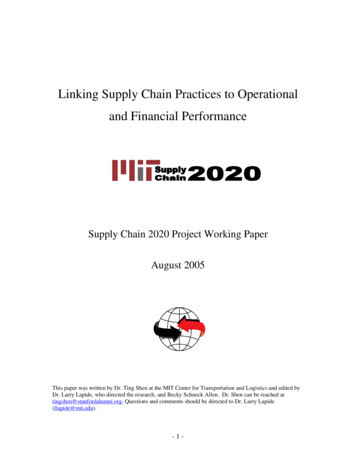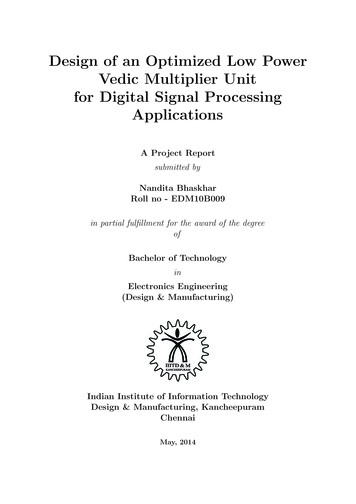
Transcription
Design of an Optimized Low PowerVedic Multiplier Unitfor Digital Signal ProcessingApplicationsA Project Reportsubmitted byNandita BhaskharRoll no - EDM10B009in partial fulfillment for the award of the degreeofBachelor of TechnologyinElectronics Engineering(Design & Manufacturing)Indian Institute of Information TechnologyDesign & Manufacturing, KancheepuramChennaiMay, 2014
BONAFIDE CERTIFICATECertified that this project report titled Design of an Optimized Low Power VedicMultiplier Unit for Digital Signal Processing Applications is the bonafide workof Ms. Nandita Bhaskhar who carried out the research under my guidance. Certifiedfurther, that to the best of my knowledge the work reported herein does not form partof any other project report or dissertation on the basis of which a degree or award wasconferred on an earlier occasion on this or any other candidate.(Dr. Binsu J Kailath)Project GUIDEAssistant ProfessorIIITD&M, KancheepuramChennai 600-127Place: ChennaiDate: 26th May, 2014
ACKNOWLEDGEMENTSI am deeply grateful to my guide and mentor, Prof. Dr. Binsu J Kailath, for herinvaluable guidance, support and encouragement, without which this project could not havebeen completed successfully. Her incredible patience and helpful advice, combined with hercare and friendship made my project work truly satisfying and pleasurable. I am indeedvery privileged to have got this opportunity to work with her.I would also like to thank all the faculty members in the Electronics Department for theirtimely suggestions, positive criticism and insightful remarks which encouraged me to givemore depth to my project. I am very grateful to my lab technicians and other staff membersfor obligingly acquiescing to all my requests. Their assistance and support truly made mywork easier. I’d like to extend my gratitude to the Computer Science Department for letting me use the labs full time. And I thank the Director for giving me this great opportunity.The acknowledgements wouldn’t be complete without mentioning my family and friends.I’d like to thank my parents and sister for giving me their love & support despite all mygrouchiness and I’d like to extend it to my close friends who put up with my peeves verycheerfully. And I am forever indebted to a very special friend of mine for encouraging methroughout & for coming to my rescue especially when I needed it. I couldn’t have done myreport without you.Nandita Bhaskhari
ABSTRACTDigital multipliers play a crucial role in various Digital Signal Processing units. Theycarry the major responsibility of power expenditure in the system and ultimately determineits speed. As a result, it is always beneficial to develop high performance, low powermultipliers.Vedic Mathematics is a set of mathematical rules, derived from ancient Indian scriptsthat makes arithmetic calculations extremely fast and simple. There are 16 rules or Sutrasexpounded in Vedic Mathematics. This report presents novel designs of a multiplier basedon the Vedic Sutras on multiplication - Urdhva Tiryakbhyam and Nikhilam.The objective of this report is to develop an optimum Vedic multiplier for 128 bit inputs.Various fresh algorithms and strategies based on both the sutras as well as a combinationof them are propounded and implemented to develop the most optimum multiplier in termsof power consumption, delay and area occupied. The proposed multipliers are designed forsynthesis using Carry Look Ahead Adders and compared with other existing multiplierslike Array, Booth and Modified Booth multipliers and the performances are evaluated. Thedesign of a novel integrated 128 bit multiplier is presented along with its mathematicalanalysis of power and is validated by its optimum time delay, area occupancy and minimumpower consumption of 4.971 ns, 75013 nm2 and 28.73 mW respectively.KEYWORDS: Integrated digital multiplier, Vedic Mathematics, Vedic Sutras, UrdhvaTiryakbyam, Nikhilam, low power, optimum area, reduced time delay, 128 bit, Array,Booth, Modified Boothii
ContentsAcknowledgementsiAbstractiiList of TablesviList of FiguresviiiList of AbbreviationsixList of Notationsx1 Introduction1.1 Vedic Mathematics - An Overview .1.2 Motivation . . . . . . . . . . . . . .1.3 Objective . . . . . . . . . . . . . .1.4 Organization of the Report . . . . .13356.2 Literature Review73 Theoretical Background – Algorithms3.1 Urdhva Tiryakbhyam . . . . . . . . . .3.2 Nikhilam . . . . . . . . . . . . . . . . .3.3 Karatsuba-Ofman Algorithm . . . . . .3.4 Carry Look Ahead Adder . . . . . . .10101213154 Design & Implementation4.1 Synthesizable Code for Hardware Efficiency . . .4.2 Vedic UT . . . . . . . . . . . . . . . . . . . . . .4.3 Scaling – The overall plan . . . . . . . . . . . . .4.3.1 Where have the optimizations taken place?4.4 UT Squaring . . . . . . . . . . . . . . . . . . . .4.4.1 Scaling – Adapted for Squares . . . . . . .4.5 Proposed Design D . . . . . . . . . . . . . . . . .4.6 Thresholding Nikhilam . . . . . . . . . . . . . . .4.7 Successive Nikhilam . . . . . . . . . . . . . . . . .19192020222222232425iii.
5 Sampoornam – the Proposed Integrated5.1 Sampoornam: Specifications . . . . . . .5.2 Sampoornam: Logic . . . . . . . . . . .5.3 Sampoornam: Implementation . . . . . .5.4 Sampoornam: Advantages . . . . . . . .Multiplier. . . . . . . . . . . . . . . . . . . . . . . . . .28282930316 Simulations and Results6.1 Vedic UT . . . . . . . .6.1.1 RTL Schematics .6.1.2 RTL Results . . .6.2 Vedic Square . . . . . .6.2.1 RTL Schematics .6.2.2 RTL Results . . .6.3 Design D . . . . . . . . .6.3.1 RTL Results . . .6.4 Nikhilam GG . . . . . .6.4.1 RTL Schematics .6.4.2 RTL Results . . .6.5 Nikhilam - SG . . . . . .6.5.1 RTL Schematics .6.5.2 RTL Results . . .6.6 Nikhilam SS . . . . . . .6.6.1 RTL Schematics .6.6.2 RTL Results . . .6.7 Logic Block . . . . . . .6.7.1 RTL Schematics .6.7.2 RTL Results . . .6.8 CLA Blocks . . . . . . .6.8.1 RTL Analysis . .6.9 Test Bench Output . . 7 Inferences7.1 Comparison –Vedic UT, Vedic Square & Design D . . . .7.2 A look at the 3 cases of Nikhilam . . . . . .7.3 Analytical Comparisons with the Vedic UT .7.4 Analysis of the Logic Block and CLA Adder7.4.1 Logic Block . . . . . . . . . . . . . .7.4.2 CLA Adder . . . . . . . . . . . . . .47.47.49.50. . 51. . 51. . 518 Comparison with Existing Work539 Power Analysis9.1 Power analysis – Sampoornam . . . . . . . . . . . . . . . . . . . . . . . . .5556iv
10 Conclusion10.1 Future Scope . . . . . . . . . . . . . . . . . . . . . . . . . . . . . . . . . .5859Bibliography60Appendix A - Vedic Sutras62Appendix B - Cadence Encounter63v
List of Tables3.1Adder Comparison – N : input size, k: group size . . . . . . . . . . . . . .184.14.24.34.44.54.6Thresholds for various multipliers . . . . . . . . . . .Multiplication of m n, base r . . . . . . . . . . . .Multiplication of m n, base r . . . . . . . . . . . .Multiplication of m n, base r . . . . . . . . . . . .Nikhilam – 1111 1111, base 1000 . . . . . . . . .Total No. of Adders Required – Successive Nikhilam.2424252526275.15.2Designs and their input constraints . . . . . . . . . . . . . . . . . . . . . .Priority Encoder – Output . . . . . . . . . . . . . . . . . . . . . . . . . . .29306.16.26.36.46.56.66.76.8Vedic UT . .Vedic SquareDesign D . . .Nikh GG . . .Nikh SG . . .Nikh SS . . .Logic . . . . .CLA Analysis.36383840424344457.17.27.3Vedic UT to Vedic Square: % reduction . . . . . . . . . . . . . . . . . . . .Vedic UT to Design D: % reduction . . . . . . . . . . . . . . . . . . . . . .Vedic UT to Nikhilam (maximum): % reduction . . . . . . . . . . . . . . .5050508.18.2As reported in Literature . . . . . . . . . . . . . . . . . . . . . . . . . . . .Vedic UT . . . . . . . . . . . . . . . . . . . . . . . . . . . . . . . . . . . .53549.19.2Submodules & their Power consumption . . . . . . . . . . . . . . . . . . .Submodules – Sampoornam . . . . . . . . . . . . . . . . . . . . . . . . . .5556.vi.
List of Figures1.11.21.31.4A typical Digital Processing SystemA MAC unit . . . . . . . . . . . . .Array Multiplier – Algorithm . . .Booth Multiplier – Algorithm . . . .3.13.23.33.43.53.63.73.83.9UT for a 3 3 Decimal Multiplication . . .UT for a 4 bit multiplication . . . . . . . .Nikhilam Example in Decimal Numbers . . .Standard Scaling Multiplication Algorithm .Karatsuba-Ofman Algorithm . . . . . . . . .Partial Full Adder (PFA) . . . . . . . . . . .4 bit CLA . . . . . . . . . . . . . . . . . .16 bit CLA adder from 4 bit CLA addersCritical Path of a 16 bit CLA . . . . . . .10. . 11.12.14.14.15.16.16.174.14.24.3Structural Programming . . . . . . . . . . . . . . . . . . . . . . . . . . . .Multiplication of two 2n bit numbers . . . . . . . . . . . . . . . . . . . .2n bit Squaring Unit . . . . . . . . . . . . . . . . . . . . . . . . . . . . .1920225.15.2Sampoornam Logic – Flowchart . . . . . . . . . . . . . . . . . . . . . . . .Sampoornam – Implementation . . . . . . . . . . . . . . . . . . . . . . . 146.152 bit Vedic UT . .4 bit Vedic UT . .8 bit Vedic UT . .16 bit Vedic UT . .32 bit Vedic UT . .64 bit Vedic UT . .128 bit Vedic UT .2 bit Vedic Square4 bit Vedic Square8 bit Vedic Square16 bit Vedic Square8 bit Nikh GG . . .16 bit Nikh GG . .32 bit Nikh GG . .64 bit Nikh GG . .323233333434353636373738393939.vii.1245
6.166.176.186.196.206.216.226.236.248 bit Nikh SG . .16 bit Nikh SG .32 bit Nikh SG .8 bit Nikh SS . .16 bit Nikh SS .32 bit Nikh SS .8 bit Nikh SS . .64 bit Vedic UT128 bit Vedic UT.40. . 41. . 41.42.42.43.44.45.467.17.27.37.47.57.6Power Consumption in nW . . . . . . . . . .Area occupied in nm2 . . . . . . . . . . . . .Worst Path Delay in ps . . . . . . . . . . . .Comparison between the 3 cases of NikhilamLogic Modules – Variation of Parameters . .CLA Adder – Variation of Parameters . . .47.48.48.49. . 51.52.viii.
List of AbbreviationsDSPDigital Signal ProcessingMACMultiplication Accumulation UnitUTUrdhva TiryakbhyamNikhNikhilamCLACarry Look AheadRCARipple Carry AdderCSKACarry Skip AdderCSLALinear Carry Select AdderHDLHardware Description LanguageavAveragedevDeviationGGGreater than Base, Greater than BaseSGSmaller than Base, Greater than BaseSSSmaller than BaseRTLRegister Transfer LogicnWnano Wattspspico secondsnm2nano square metersDNGData not givenMSBMost significant BitLSBLeast Significant BitASICApplication Specific Integrated Circuitix
List of Notations XOR#number ofr’b0r bit number is 0A[(n 1) : 0]n bit number with ith bit given by A[i] implies / leads toaa complementx
Chapter 1IntroductionDigital signal processing (DSP) is firmly being established as an extremely vibrantand vital field in the Electronics industry. The past few decades have seen an exponentialgrowth in the number of products and applications that involve DSP, with a wide reach intodiverse domains such as audio signal processing, digital image processing, video compression,speech processing, speech recognition, digital communications, RADAR, SONAR, financialsignal processing, seismology and even biomedicine. Especially since computers have evolvedinto powerful machines capable of high computational complexity, almost all the signalprocessing takes place in the Digital Domain.Frequently used algorithms include the Convolution operation, Finite Impulse Response(FIR) Filter, Infinite Impulse Response (IIR) Filter, and Fast Fourier Transform (FFT), allof which require intensive computation. DSP algorithms generally require a large numberof mathematical operations to be performed quickly and repeatedly on a series of incomingdata. The signals are constantly converted from analog to digital, digitally manipulated,and then converted back to analog.Figure 1.1: A typical Digital Processing SystemMost general–purpose microprocessors and operating systems can execute DSP algorithms successfully, but consume more power and occupy a larger area which is not suitablefor most portable applications like those on mobile phones, biomedical devices, etc. Aspecialized digital signal processor, the Digital Signal Processor (DSP processor),having different architectures and features optimized specifically for digital signal processing,is hence preferred. This will tend to provide a lower-cost solution, with better performance,lower latency and lesser power consumption. Thus, the efficiency in the design of the underlying hardware in the DSP processors will reflect in the performance of the applications.1
One of the most important hardware structures in a DSP processor is the MultiplyAccumulate (MAC) unit. A conventional MAC unit consists of an n bit multiplier, theoutput of which is added to/subtracted from the contents of an Accumulator that storesthe result. Thus, the MAC unit implements functions of the type A BC. The abilityto compute with a fast MAC unit is essential to achieve high performance in many DSPalgorithms, and which is why there is at least one dedicated MAC unit in all of the moderncommercial DSP processors.Figure 1.2: A MAC unitHence as it can be observed, Digital Multipliers are the core components of all MACunits and hence all DSP processors. The multiplier lies in the Critical Delay Pathand ultimately determines the performance of any algorithm in the processor. Currently,multiplication time is still the major factor in determining the instruction cycle time of aDSP chip apart from contributing to the bulk of its power expenditure. Since multiplicationdrains power quickly and dominates the execution time of most DSP algorithms, thereis a need for Low–Power, High–Speed Multipliers. In this concern, design of efficientmultipliers has long been a topic of interest to digital design engineers.The other function that a MAC unit inherently performs is the addition operation.It is one of the most essential operations in the instruction set of any processor. Otherinstructions such as subtraction and multiplication employ addition in their operations,and their underlying hardware is primarily dependent on the addition hardware. Hencethe performance of a design will be often be limited by the performance of its adders. Itis therefore as important to choose the correct adder to implement in a design as it is tochoose a multiplier because of the many factors it affects in the overall chip.2
The main expected features of any DSP block, be it an adder or a multiplier, arespeed, accuracy and easy integrability. A number of interesting algorithms have beenreported in literature, each offering different advantages and having trade-offs in termsof speed, circuit complexity, area and power consumption, forming an active area of research.1.1Vedic Mathematics - An OverviewVedic Mathematics is the name given to a set of rules derived from Ancient IndianScriptures, elucidating different mathematical results and procedures in simple and understandable forms. The word Vedic is derived from the word Veda which means thestore–house of all knowledge.It is claimed to be a part of the Sthapatya Veda, a book on civil engineeringand architecture, which is an Upaveda (supplement) of the Atharva Veda. It coversexplanations of several modern mathematical terms including arithmetic, geometry (plane,co-ordinate), trigonometry, quadratic equations, factorization and even calculus.The beauty of Vedic mathematics lies in the fact that it reduces the otherwise cumbersomelooking calculations in conventional mathematics to very simple ones. This is because theVedic formulae are claimed to be based on the natural principles on which the human mindworks.Vedic mathematics is mainly based on 16 Sutras (or aphorisms) dealing with variousbranches of mathematics like arithmetic, algebra, geometry, etc. Of these, there are twoVedic Sutras meant for quicker multiplication. They have been traditionally used for themultiplication of two numbers in the decimal number system. They are –1. Nikhilam Navatashcaramam Dashatah: All from 9 and last from 102. Urdhva Tiryakbhyam: Vertically and crosswise1.2MotivationMultiplication involves two basic operations – the generation of partial products andtheir accumulation. Clearly, a smaller number of partial products reduces the complexity,and, as a result, reduces the partial products accumulation time.When two n bit numbers are multiplied, a 2n bit product is produced. Previousresearch on multiplication, i.e. shift and add techniques, focused on multiplying two n bitnumbers to produce n partial products and then adding the n partial products to generatea 2n bit product. In which case, the process is sequential and requires n processor cyclesfor an n n multiplication. Advances in VLSI have rendered Parallel Multipliers – fullycombinational multipliers, which minimize the number of clock cycles/steps required, feasible.3
Two most common multiplication algorithms followed in the digital hardware are theArray multiplication algorithm and Booth multiplication algorithm. The computationtime taken by the array multiplier is comparatively less because the partial products arecalculated independently in parallel. The delay associated with the array multiplier is thetime taken by the signals to propagate through the gates that form the multiplication array.In the case of Booth multiplication algorithm, it multiplies two signed binary numbers intwo’s complement notation. Andrew Donald Booth used desk calculators that were fasterat shifting than adding and created the algorithm to increase their speed. It is possible toreduce the number of partial products by half, by using the technique of Radix-4 Boothrecoding. But both do have their own limitations. The search for a new design of a multiplierwhich will radically improve the performance is always on.Figure 1.3: Array Multiplier – Algorithm4
Figure 1.4: Booth Multiplier – AlgorithmThe main motivation of this project is to make use of the simplicity of the Vedicsutras and adapt it for binary arithmetic to get an efficient and optimum digital multiplierfulfilling the demands of the growing technology. This, if implemented correctly, has thecapability to reduce the computational time of DSP applications to a fraction of what itis today and revolutionize the standard power consumption of DSP chips. Fortunately orunfortunately, the potential of the Vedic Algorithms has remained untapped and unplundered for long. It would be a source of pride to prove that the Indian–originated methodscan surpass the existing algorithms and to use them widely in various applications for thebenefit of the industry.1.3ObjectiveThe aim of this project is to design and implement an optimized digital multiplier whichwill multiply two real integers for DSP applications incorporating Vedic Multiplicationprinciples.The goals are: To reduce the computational time To optimize the area occupied To minimize the power consumed5
To realize it for 128 bits To develop novel algorithms for obtaining a highly optimum multiplier To design and implement an integrated multiplier which will decide the algorithm tobe used depending on the given inputs To finalize on an optimum adder and use it to implement all the addition operations1.4Organization of the ReportChapter 1, the Introduction describes the need for efficient multipliers followed by abrief overview of Vedic Sutras. It illustrates the motivation behind taking up this projectand states the objectives.Chapter 2, Literature Review, deals with all the multiplication and addition schemesreported in literature. It puts forward the concepts already proposed on related areas injournals and conferences.Chapter 3, Theoretical Background - Algorithms presents the Vedic Multiplication Algorithms – Urdhva Tiryakbhyam and Nikhilam, in detail, then proceeds with anexplanation of the Karatsuba-Ofman Algorithm and concludes by justifying the selection ofthe Carry Look Ahead (CLA) Adder.Chapter 4, Design & Implementation, expounds on the main work done in theproject, beginning with an explanation of the modular hierarchy followed in this project,and the moving on to the actual logic employed in writing synthesizable code for eachmodule and finally concluding with an emphasis on Structural modelling as compared tobehavioural modelling.Chapter 5, Sampoornam – the Proposed Integrated Multiplier presents a novelmultiplier designed such that the logic decides which algorithm is to be used based on theinput along with techniques employed to build this optimum, smart multiplier.Chapter 6 gives all the Simulations and Results while Chapter 7 presents the Inferences of the results.Chapter 8 is dedicated to Power Analysis, which gives a true picture of the powerconsumed in real time, based on mathematical analyses.Finally, Chapter 9, the Conclusion completes the report by summarizing the work andconsidering the future scope .6
Chapter 2Literature ReviewHere, a brief summary of the work that has already been done in this field with VedicMultipliers is presented. A few results are noted down for comparison later.The implementation of an 8 bit Vedic multiplier enhanced in terms of propagationdelay when compared with conventional multipliers like Array multiplier, Braun multiplier,Modified Booth multiplier and Wallace tree multiplier has been given by Pavan KumarU.C.S, et al, 2013. Here, they have utilized an 8 bit barrel shifter which requires only oneclock cycle for n number of shifts. The design could achieve propagation delay of 6.781 nsusing barrel shifter in base selection module and multiplier.S. Deepak, et al, 2012, have proposed a new multiplier design which reduces the numberof partial products by 25 %. This multiplier has reported to have been used with differentadders available in literature to implement multiplier accumulator (MAC) unit and parameters such as propagation delay, power consumed and area occupied have been comparedin each case. From the results, Kogge Stone adder was been chosen as it was claimed tohave provided optimum values of delay and power dissipation. The results obtained havebeen compared with that of other multipliers and it has been reported that the proposedmultiplier has the lower propagation delay when compared with Array and Booth multipliers.A high speed complex multiplier design (ASIC) using Vedic Mathematics has also beenreported by Prabir Soha, et al, 2011. A complex number multiplier design based on theformulas of the ancient Indian Vedic Mathematics, was said to have been implemented inSpice spectre and compared with the mostly used architecture like distributed arithmetic,parallel adder based implementation, and algebraic transformation based implementation.It claims to have combined the advantages of the Vedic mathematics for multiplicationwhich encounters the stages and partial product reduction. The proposed complex numbermultiplier has been reported to offer 20% and 19% improvement in terms of propagationdelay and power consumption respectively, in comparison with parallel adder based implementation. The corresponding improvement in terms of delay and power was reportedto be 33% and 46% respectively, with reference to the algebraic transformation basedimplementation.Mohammed Hasmat Ali, et al, 2013, have presented a detailed study of different multipli7
ers based on Array Multiplier, Constant coefficient multiplication (KCM) and multiplicationbased on Vedic Mathematics. The reported multipliers have been coded in Verilog HDL(Hardware Description Language) and simulated in ModelSimXEIII6.4b and synthesized inEDA tool Xilinx ISE12. All multipliers are compared based on LUTs (Look up table) andpath delays. Results report that Vedic Urdhva Tiryakbhyam sutra is the fastest Multiplierwith least path delay. The computational path delay for proposed 8 8 bit Vedic UrdhavaTiryakbhyam multiplier was reported to be 17.995 ns.Karatsuba-Ofman algorithm has been reported to have been used by M.Ramalatha, etal, 2009, in the implementation of an efficient Vedic multiplier which is meant to have highspeed,less complexity and consuming less area. Also after using this multiplier module aVedic MAC unit was constructed and both these modules were integrated into an arithmeticunit along with the basic adder subtractor.A generalized algorithm for multiplication has been reported by Ajinkya Kala, 2012,through recursive application of the Nikhilam Sutra from Vedic Mathematics, operatingin radix - 2 number system environment suitable for digital platforms. Statistical analysishas been carried out based on the number of recursions profile as a function of the smallermultiplicand. The proposed algorithm was claimed to be efficient for smaller multiplicandsas well, unlike most of the asymptotically fast algorithms. It was implemented for samesized inputs but an algorithm was presented which could be used to compute multiplicationof two variable bit numbers. The algorithm was reported to solely depend on the ratio of thenumber of 1’s and 0’s used to represent a number in binary, rather than on the magnitudeof the number. It was mentioned that as the ratio approaches 1, the number of operationsrequired for the multiplication increases and decreases as the ratio tends to move close to 0.Ramachandran.S, et al, 2012, have thought of an Integrated Vedic multiplier architecture,which by itself selects the appropriate multiplication sutra (UT or Nikhilam) based on theinputs. So depending on inputs, whichever sutra is faster, that sutra is to be selected bythe proposed integrated Vedic multiplier architecture. It was implemented for 16 bits butthere has not been a clear report on the results or the design.Kabiraj Sethi, et al, 2012, have proposed a high speed squaring circuit for binary numbersis proposed. High speed Vedic multiplier is used for design of the proposed squaring circuit.Only one Vedic multiplier is used instead of four multipliers as reported previously. Inaddition, one squaring circuit is used twice.In paper presented by G.Ganesh Kumar, et al, 2012, the Verilog HDL coding of Urdhvatiryakbhyam Sutra for 32 32 bits multiplication and their FPGA implementation by XilinxSynthesis Tool on Spartan 3E kit have been done and the output has been displayed on LCDof Spartan 3E kit. The synthesis results show that the computation time for calculating theproduct of 32 32 bits is 31.526 ns.The designs of 16 16 bits, 32 32 bits and 64 64 bits Vedic multiplier havebeen implemented as reported by Vinay Kumar, 2009 on Spartan XC3S500-5-FG320 and8
XC3S1600-5-FG484 device according to this thesis. The computation delay for 16 16 bitsBooth multiplier was 20.09 ns and for 16 16 bits Vedic multiplier was 6.960 ns. Alsocomputation delays for 32 32 bits and 64 64 bits Vedic multiplier was obtained 7.784ns and 10.241 ns respectively.A new reduced-bit multiplication algorithm based on Vedic mathematics has beenproposed by Honey Durga Tiwari, et al, 2008. The framework of the proposed algorithmis taken from Nikhilam Sutra and is further optimized by use of some general arithmeticoperations such as expansion and bit shifting to take full advantage of bit-reduction in multiplication. The computational efficiency of the algorithm has been illustrated by reducinga general 44 multiplication to a single 22 multiplication operation.Manoranjan Pradhan, et al, 2011, have presented the concepts behind the ”UrdhvaTiryagbhyam Sutra” and ”Nikhil
Vedic Mathematics is a set of mathematical rules, derived from ancient Indian scripts that makes arithmetic calculations extremely fast and simple. There are 16 rules or Sutras expounded in Vedic Mathematics. This report presents novel designs of a multiplier based on the Vedic Su
